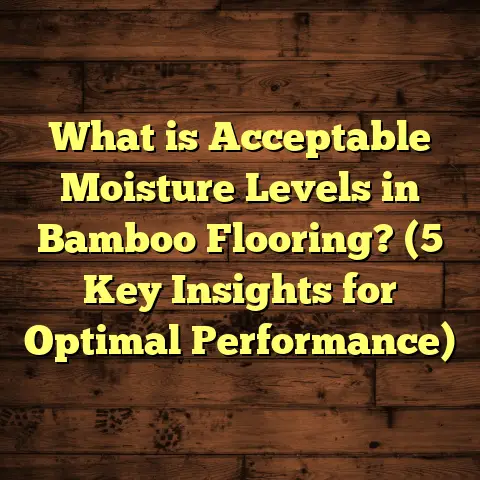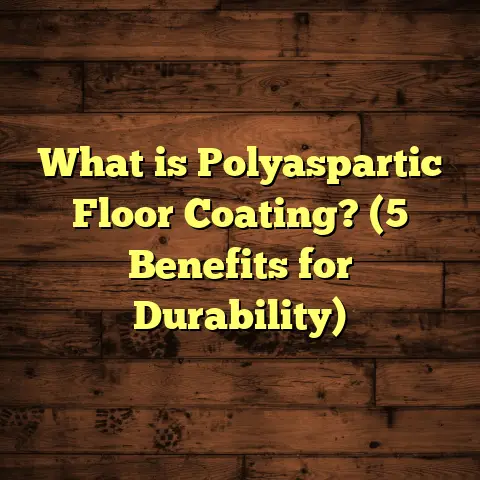What is White Powder on Basement Floor? (5 Causes to Investigate)
Investing in a home is one of the biggest financial and emotional commitments you’ll ever make. Over the years, I’ve come to realize that every detail matters—especially things that seem small or insignificant, like a white powder on your basement floor. At first glance, it might seem harmless or just an odd quirk. But if you’re like me and want to protect your investment, you know it’s worth investigating what’s causing that powder and whether it signals something more serious.
I remember the first time I saw this white powder show up during a basement renovation. I was called in by a homeowner worried about their flooring. The powder looked like dust but felt chalky and left a residue on my gloves. It got me thinking: What exactly is this stuff? Why does it happen? And importantly, how do I help homeowners deal with it effectively?
Over the years, through countless basement projects, personal research, and working alongside structural engineers and moisture specialists, I’ve gathered insights that I want to share here. This article digs into the five main causes of white powder on basement floors, backed by data and real-world cases. I’ll also share hands-on advice, tips from my own experience, and how I use modern tools like FloorTally to plan flooring repairs after addressing these issues.
So, grab a cup of coffee and let’s talk basement floors—you might be surprised how much this simple white powder can tell you about your home’s health.
The Mystery of White Powder on Basement Floors: What’s Really Going On?
When I first got involved in basement flooring work over a decade ago, I noticed how often clients pointed out white powdery patches or crusts on their concrete floors. Sometimes these spots were small, sometimes they covered large areas. People would ask me: “Should I be worried? Is this mold? Is my foundation crumbling?”
In my early days, I didn’t have all the answers. I’d test for moisture, check the client’s history of water problems, and sometimes suggest sealing or cleaning. But the truth is, white powder on basements is not one-size-fits-all. It’s a symptom with multiple possible causes—and each cause demands a different approach.
Here are the five main causes I’ve found in my work:
- Efflorescence (salt deposits)
- Concrete dusting or wear
- Mold or mildew growth
- Pest-related residue
- Mineral deposits from hard water
Before we unpack these, let me share why this matters so much.
Why Should You Care About This White Powder?
You might think: “It’s just some dust or powder. Why fix it if it doesn’t smell or damage anything immediately?”
Well, here’s the thing: White powder often points to moisture problems. Moisture in basements is the enemy number one for flooring materials, indoor air quality, and structural integrity.
I’ve seen basements with efflorescence that later developed cracks in the concrete slab or walls due to ongoing water intrusion. Floors that dust heavily often need more frequent repairs or replacement. Mold spores can trigger allergies and asthma for families living above.
So spotting white powder early helps you:
- Detect hidden moisture issues before they escalate.
- Avoid costly repairs down the road.
- Choose the right flooring materials that can handle basement conditions.
- Ensure a safe, healthy environment in your home.
1. Efflorescence: Salt Crystals Telling a Moisture Story
Efflorescence is hands down the most common cause of white powder on basement floors or walls. I’ve seen it hundreds of times during inspections and renovations.
Here’s how it works:
- Water travels through concrete or masonry carrying dissolved salts.
- When water reaches the surface and evaporates, salts crystallize.
- These salt crystals appear as white powder or flaky deposits.
What does efflorescence look like?
It often looks like chalky white patches or streaks that can be wiped away with water but usually come back after moisture returns. The texture is dry and powdery.
Why does it happen?
Concrete is porous, meaning it has tiny holes that allow water to migrate through. If your basement has any moisture source—leaks, groundwater pressure, poor drainage—water will carry salts upward.
Data point: According to a 2019 study by the Building Research Establishment (BRE), over 65% of basements in areas with high groundwater levels show varying levels of efflorescence.
I remember a client in Ohio whose basement floor was covered with this white salt after every heavy rain. We discovered their gutters discharged water too close to the foundation. Fixing the gutters and adding proper grading reduced water seepage drastically.
How to Check for Efflorescence
Try this simple test:
- Take a damp cloth and rub the white powder.
- If it dissolves easily leaving no stain, it’s likely efflorescence.
- If it resists water or feels gritty, look at other causes.
Why You Shouldn’t Ignore Efflorescence
While efflorescence itself isn’t toxic or harmful, it signals moisture presence that can cause:
- Concrete deterioration over time.
- Mold growth in hidden areas.
- Damage to wood framing or flooring materials installed over concrete.
From my experience, ignoring efflorescence usually means you’ll pay more later fixing bigger water damage issues.
How to Fix Efflorescence Problems
Here’s what I recommend after spotting efflorescence:
- Reduce Moisture Sources: Check gutters, downspouts, grading around your foundation.
- Seal Cracks: Small cracks letting in water should be professionally sealed.
- Improve Basement Ventilation: Lower humidity levels using dehumidifiers.
- Apply Sealers: After drying out your floor/walls, apply breathable masonry sealers to reduce moisture migration.
In many cases, fixing drainage around your home solves the problem long-term.
2. Concrete Dusting: When Floors Wear Out
If you’ve ever walked barefoot on a concrete floor and noticed fine dust sticking to your feet, you’re experiencing concrete dusting—a sign of surface wear.
This white powder is made up of tiny particles of concrete breaking down due to abrasion or poor finishing.
I had one project where a client complained their basement floor was always dusty despite regular cleaning. Upon inspection, the concrete slab had been poured over poorly compacted soil with no vapor barrier beneath. Over time, foot traffic caused surface degradation releasing fine dust.
Causes of Concrete Dusting
- Poor concrete mix or finishing
- Excessive wear from heavy foot traffic or furniture movement
- Lack of proper curing during installation
- Exposure to moisture causing surface weakening
How to Test if It’s Concrete Dusting
If the white powder feels dusty and doesn’t dissolve in water like efflorescence does, chances are it’s concrete dusting.
How to Deal With Dusting Floors
- Seal Your Floor: Applying a concrete sealer locks down loose particles.
- Polish the Surface: Polishing densifies concrete making it harder and less dusty.
- Repair Thin Areas: If wear is significant, consider grinding and applying overlays.
Concrete dusting isn’t usually dangerous but can be annoying and messy.
3. Mold or Mildew: White Fuzzy Growth That Needs Attention
Mold isn’t always black or green; sometimes it appears as white powdery spots or fuzzy coatings on damp surfaces.
In basements where moisture lingers and ventilation is poor, mold finds its perfect environment.
At one job site, a homeowner was worried about white powder near their stored boxes. It turned out to be a powdery mold growing on dust and organic debris on the floor.
Signs That White Powder Is Mold
- Soft or fuzzy texture rather than chalky
- Musty odor nearby
- Persistent dampness or humidity
- Stains that don’t wipe off easily
Health Risks Associated with Mold
Mold spores can cause allergic reactions, respiratory issues, and worsen asthma symptoms—especially for kids and elderly residents.
How to Confirm Mold Presence
DIY mold test kits are available but for best results hire a professional for sampling and lab analysis.
How to Treat Mold in Basements
- Identify and eliminate moisture sources.
- Clean affected areas with fungicidal cleaners.
- Use protective gear during cleaning.
- Improve ventilation and install dehumidifiers.
4. Pest Residue: When Bugs or Rodents Leave White Powder Behind
Sometimes what looks like harmless white powder is actually evidence of pest activity.
Termites produce frass (wood particles mixed with droppings) that can look like tiny white dust piles near baseboards or wooden structures.
Rodents shed fur and leave urine crystal deposits which sometimes appear as white powdery spots around nesting areas.
One memorable case involved carpenter ants leaving white sawdust-like piles near bathroom walls.
How to Identify Pest Residues
Look for:
- Accompanying signs like gnawed wood or droppings
- Trails or nests near affected areas
- Unusual smells from rodent urine
What To Do If You Suspect Pest Issues
Call pest control experts immediately—they’ll identify pests and recommend treatment plans.
Ignoring pest residue can lead to structural damage and increased infestation risks.
5. Mineral Deposits from Hard Water: Crusty White Build-up
Basements with sump pumps, drains, or water heaters can sometimes develop mineral deposits from hard water evaporation.
Calcium carbonate and magnesium salts leave behind chalky crusts similar to efflorescence but linked directly to water quality rather than moisture migration through concrete.
How To Check for Mineral Deposits
Try scraping off some deposits; mineral buildup is usually hard and crusty rather than powdery.
Vinegar-based cleaners dissolve these deposits effectively without harming surfaces.
Using Tools Like FloorTally for Flooring Projects in Basements With White Powder Issues
After identifying and fixing moisture or pest problems causing white powder buildup, many homeowners want to upgrade their basement floors.
I’ve found FloorTally incredibly useful for planning these projects because:
- It consolidates local labor and material costs into one estimate.
- Helps factor in additional costs for moisture barriers or sealers needed in basements.
- Saves time by avoiding multiple quotes.
- Improves client understanding with clear cost visuals.
For example, when budgeting for waterproof vinyl planks over a sealed concrete slab with previously heavy efflorescence problems, FloorTally helped me provide realistic estimates factoring in underlayment costs for vapor control.
My Basement White Powder Experience: A Detailed Story
A few years back at my own house after an exceptionally wet spring, I noticed fine white patches appearing on my basement floor near the foundation walls. At first glance, I thought maybe mold—but when I touched it, it was dry and chalky.
I took moisture readings around the area and found elevated levels near cracks at the base of the wall. The culprit was classic efflorescence caused by groundwater seeping through tiny cracks during heavy rains.
To fix it:
- I improved exterior grading so water moved away from the foundation.
- Repaired gutters directing downspouts further from the house.
- Sealed cracks inside with epoxy injections.
- Installed a high-capacity dehumidifier to keep humidity low year-round.
- After drying out for several months, applied masonry sealers on floors and walls.
The white powder disappeared completely within six months. This personal experience reinforced how important exterior drainage is for protecting basements—and why ignoring white powder isn’t wise.
Additional Tips from My Experience
Here are some practical nuggets to keep in mind if you’re dealing with basement floor powders:
- Always check outside first! Gutters clogged or downspouts too close often cause hidden moisture problems.
- Use a hygrometer to monitor basement humidity; keep it below 60% ideally.
- When cleaning powders off floors, avoid harsh chemicals that might react with concrete; mild vinegar solutions work well for efflorescence.
- Consider installing vapor barriers beneath new flooring installations after fixing moisture issues.
- Don’t rush into floor replacements before addressing underlying causes—you’ll just face repeat problems otherwise.
Summary Table: Causes of White Powder on Basement Floor & Actions
| Cause | Appearance | Test | Key Action |
|---|---|---|---|
| Efflorescence | Chalky white salt | Dissolves in water | Fix drainage; seal cracks |
| Concrete Dusting | Fine dusty particles | Does not dissolve | Seal/polish floor |
| Mold/Mildew | Soft/fuzzy white spots | Doesn’t wipe off | Mold remediation; improve vent |
| Pest Residue | Tiny pellets/dust | Look for pest signs | Pest control |
| Mineral Deposits | Hard chalky crust | Scrapes off hard | Vinegar cleaning; water treatment |
I hope this detailed look at the causes of white powder on basement floors helps you feel more confident spotting problems early—and taking effective action before they become costly headaches!
If you want advice tailored to your specific situation or ideas for flooring options after fixing these issues, just let me know—I’m always happy to help!
Thanks for reading all the way through—I guess we really covered everything about that mysterious white powder now!





